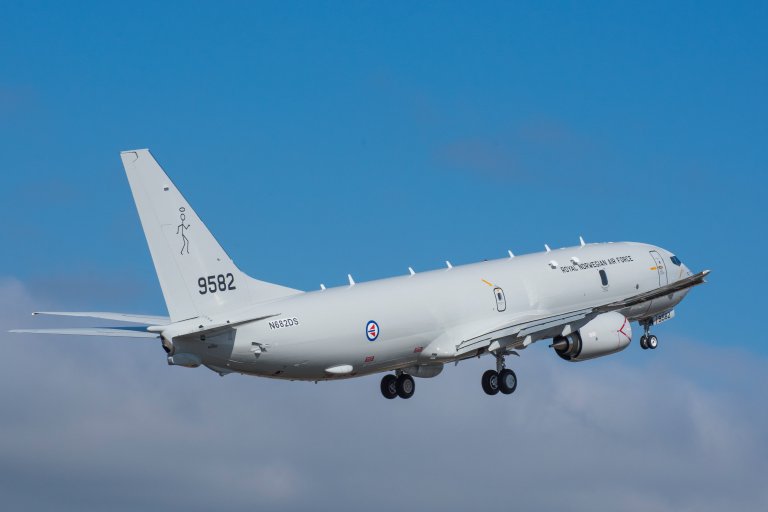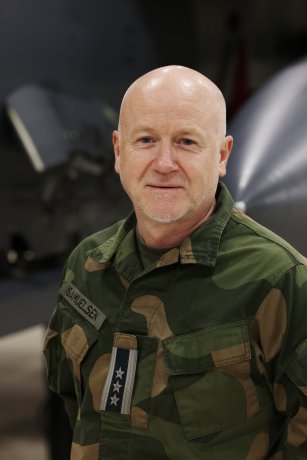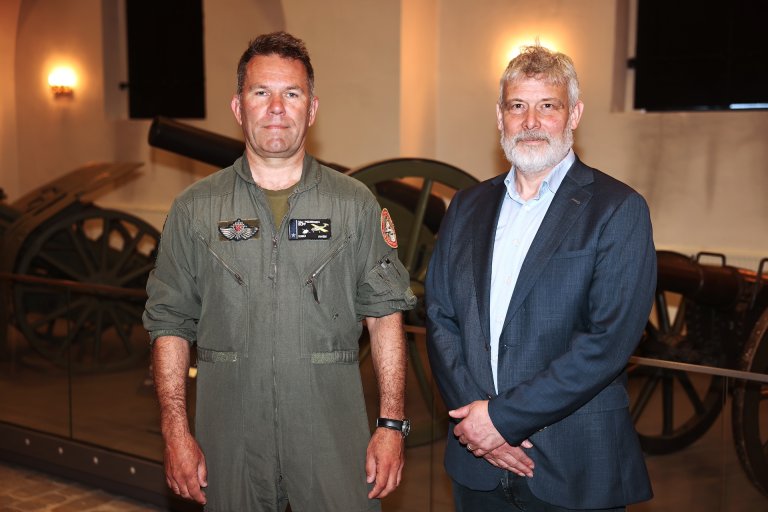
Groundbreaking military cooperation between the US and Norway
For the first time, the Americans have allowed another country to take control of an American bomb on its way to the target. A Norwegian-developed concept for network weapons was recently tested at Andøya, together with the US Air Force, and the result is groundbreaking.
Andøya, Nordland: On Wednesday, 14 May, the Norwegian Armed Forces wrote themselves into the history books together with the United States, our close NATO ally. Two F-15E fighter jets from the US Air Force flew in towards the Norwegian coast, loaded with two glide bombs. As soon as the fighter planes dropped the bombs, Norwegian soldiers took control of them, via a network, and steered them towards targets they themselves had designated. Along the way, they received updates from various sensors that had been deployed, including from our P-8 surveillance aircraft, and adjusted the course of the bombs.
Network weapons - weapons you can communicate with after they’re fired
Because the bombs on board the two F-15 planes were network weapons. These are weapons that are integrated into a digital network of sensors, command systems, and platforms. Via a built-in radio transmitter, military personnel can communicate with the weapon after it has been fired, change its course, change the target it is going to attack, and await or abort an attack. All based on updates they receive in real time.

Historical event

And this is what went smoothly recently, and thus a new chapter was written in the history of the good military cooperation between the United States and Norway.
"It was fantastic that this worked. It is the first time this weapon has been released in a live version. And it was also the first time someone from the Norwegian armed forces tested a live network weapon," says Colonel Roger Samuelsen.
He is the head of NOBLE, a group in the Norwegian Armed Forces that is affiliated with the Norwegian Armed Forces' operational headquarters (FOH). Noble is an abbreviation for Norwegian Battle Lab & Experimentation, and the group's task is to strengthen the Norwegian Armed Forces' operational capability through concept development and experimentation.
Network weapons
Increased precision
- The weapon can receive real-time data from external sensors.
- This improves the ability to detect targets and follow them, which in turn provides more accurate matches and reduces the risk of accidental injuries.
- The weapon can be controlled and change course or target after the weapon is fired, based on real-time updates.
Increased range, and safety
- Since the platform supplying the weapon, or the weapon itself, does not need to "see" the target, but can be controlled and/or updated with coordinates from other devices in the network, the weapon can be fired at a safe distance without the platform supplying the weapon having to expose itself.
Flexible target selection
- Goals can be identified and prioritized dynamically based on the situation.
A big step for Norway and the Armed Forces
Over several years, NOBLE has developed a joint operational concept for the planning, coordination, implementation, and management of a network weapon. And it was this system that was tested on Andøya.

A result, the Chief of the Norwegian Armed Forces' Operational Headquarters, Vice Admiral Rune Andersen, was very pleased with:
– This is a good example of how we develop the Norwegian Armed Forces and maintain a technological lead. Our ability to deliver power at a distance and with precision is becoming an increasingly important part of our defense concept, says Andersen.
He also highlights the good relationship between the US and Norway:
–The implementation is also based on a high degree of trust and integration between close allies, he says.
A shared ability to conduct complex, network-enabled engagements
Andersen’s view is supported by Captain Brett Stell in the 494th Fighter Squadron, US Air Force:
– Jotun Strike isn't just a joint exercise - it's a demonstration of what warfighting looks like in the future. Together with our Norwegian partners, we're proving that a weapon launched from a U.S. platform can be guided by a Norwegian sensor across domains and distances, says Stell, and continues:
– This level of integration shows our shared ability to conduct complex, network-enabled engagements-even in contested environments.
The big test
NOBLE has worked thoroughly on its concept for network weapons. The work was initiated in 2019 and has since kept pace with 2025 as the deadline.
– This was the big test. I was very excited to see if the software we have developed would work as intended, even though we have done all the preparations and tests that were possible in advance, says Colonel Roger Samuelsen, and underline that the successful outcome of the test demonstrates that NOBLE and the Norwegian Armed Forces now can both plan, lead, coordinate and carry out an engagement with network weapons.
Can give us access to formidable firepower
– And not least, we have demonstrated together with our most important ally that together with them we can carry out advanced operations. It could potentially give us access to formidable firepower, delivered by our most important ally, as we take control of the weapon and steer it towards our priority targets, says Samuelsen.
The Norwegian Joint Operational Concept for Network Weapons
- Work on the concept for network weapons began in 2019. The goal was to have a concept ready in 2025.
- The work came as a result of several new platforms being introduced into the Norwegian Armed Forces at the same time. Both the F-35, the P-8 surveillance aircraft, and the Joint Strike Missile.
- In addition, the US Armed Forces developed a set of messages/commands that work for network weapons.
- An operation with network weapons requires good planning and a high degree of synchronization. One party drops weapons, several other parties provide data that can affect the target, and the operation can involve many platforms and multiple branches.
- NOBLE saw the need to create a concept across all branches and platforms that works with network weapons.
- The Armed Forces' surveillance aircraft, the P-8, already has built into its systems the ability to control a network weapon. The fighter jets, the F-35, will get it.
Using available technology put together in a new way
The joint operational concept for network weapons has been developed in close cooperation with Norwegian industry. Samuelsen says that they have only used already available technology, but put this together in a way that provides new opportunities:
– We have developed software that is installed in our control and command systems, and which makes it possible to take control of and control a network weapon.
The concept uses Link16 to communicate with. It is a military tactical data link network, used in the Armed Forces since 2003, that is encrypted and almost impossible to jam. It provides the opportunity to communicate across platforms, so that everyone can share the same situational awareness and communicate within the system.
The concept before only tested via simulation
The Norwegian concept has previously only been tested via simulations. The team at NOBLE has managed to create complex exercise scenarios, with many components involved. But the opportunity to exercise effectively with live weapons, and together with an allied partner such as the United States, represents a huge boost. Therefore, there was great excitement associated with the experiment on Andøya.
– We have developed this system over time and also tested it on large exercises in the USA in the past, against other simulators. And then we have repeatedly been told that we have come further with the technology than others, says Samuelsen, and believes this also contributed to the Americans wanting to provide live weapons and planes on Andøya.
The United States sees Norway as an important ally
The United States is also extracting its effects from this cooperation:
– Our presence here isn't just about Europe - it's about homeland defense forward. Threats to the U.S. can originate beyond the Western Hemisphere, and our forward capabilities in the European theater are essential for early warning, rapid response, and deterrence. Exercises like Jotun Strike make our collective force more lethal, more integrated, and ready to fight and win together, says Captain Brett Stell, from the 494th Fighter Squadron.
Exercises like Jotun Strike make our collective force more lethal, more integrated, and ready to fight and win together
Captain Brett Stell, from the 494th Fighter Squadron, US Air Force, about the test at Andøya.
NATO has shown interest in the Norwegian concept
The test is a bilateral collaboration. But other NATO allies may also have the chance to use the concept in due course:
"Those who work with concept development in NATO have already shown interest in the Norwegian concept, and we find that there are many allies who follow our development and are interested in the control software that we have developed in collaboration with the Norwegian software company Teleplan," says Samuelsen.
Extracting the effect of major procurements
For Norway, this is also about being able to utilize the resources we already have:
– We are a small nation that needs to utilize our resources efficiently. Today's result shows that we now could take advantage of the effect of the major acquisitions the Armed Forces have made in recent years, says Samuelsen, referring to fifth-generation weapons such as the F-35 – our new fighter jets, the P-8 – the new surveillance aircraft, and the new Norwegian-made missile Joint Strike Missile.
– After this test, I am relieved and proud. Proud of the successful result. And proud of my personnel, who have worked together with Norwegian industry for several years to develop solutions that can control such weapons, says Samuelsen.

Putting Norway at the forefront of technology
He is clear that this places Norway technologically at the forefront. There are not many nations that have this weapon or the technology within reach.
– This proves that NOBLE and the Norwegian Armed Forces are at the forefront when it comes to utilizing available technology, putting it together in a smart way, and adapting our processes so that we can exploit the potential of our new strategic procurements such as the P8, F-35 and Joint Strike Missile, he states.
NOBLE's role in innovation work in the Norwegian defense sector
In the Armed Forces' long-term plan, section 10.2.2.2 Coordination of innovation environments is stated
The Government will:
- Further develop the triangular cooperation between the Armed Forces, FFI and the defense industry and exploit the opportunities for innovation that lie in closer and expanded cooperation between the defense sector, allies, the business sector, education and research communities and government authorities.
- Coordinate the innovative environments in the defense sector and put them in a systematical order. The purpose is to increase innovation capacity, better coordinate activities with future materiel investments and contribute to better resource utilization across established environments.
- The Norwegian Battle Lab & Experimentation (NOBLE) at the Norwegian Joint Headquarters (FOH) will be strengthened and given an expanded responsibility for following up the concept development and experimentation until innovations are realized. Innovation can include changes in organization, new use of technology, acquisition of new technology, or a combination of these.
- NOBLE will have a clearer role in the work of selecting which ideas are to be further developed based on operational priorities and user needs.
